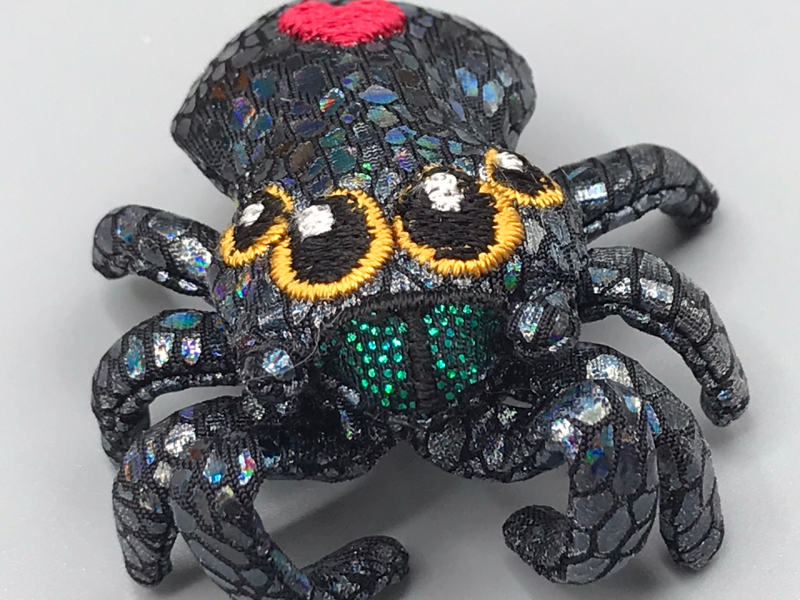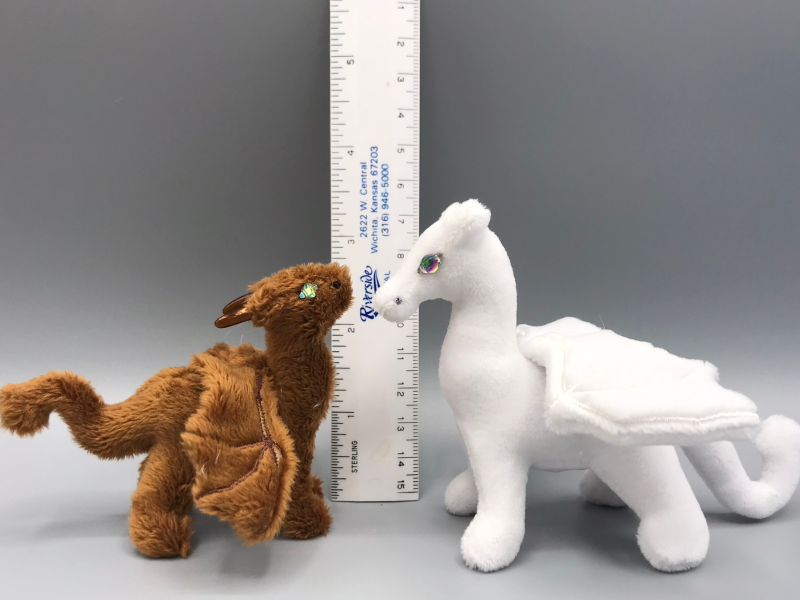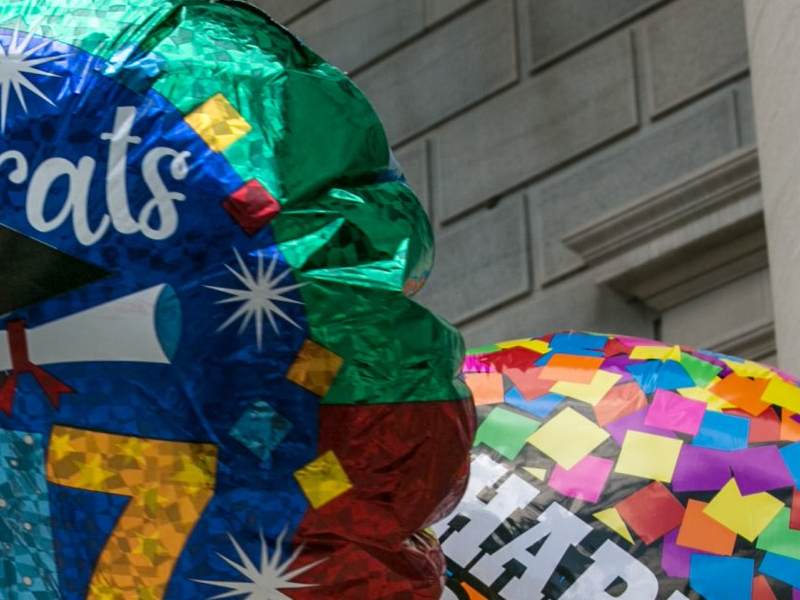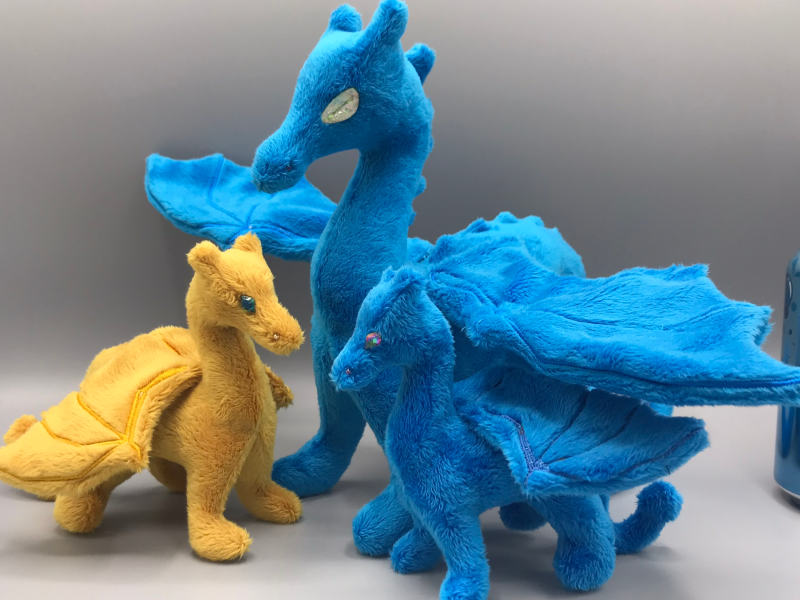
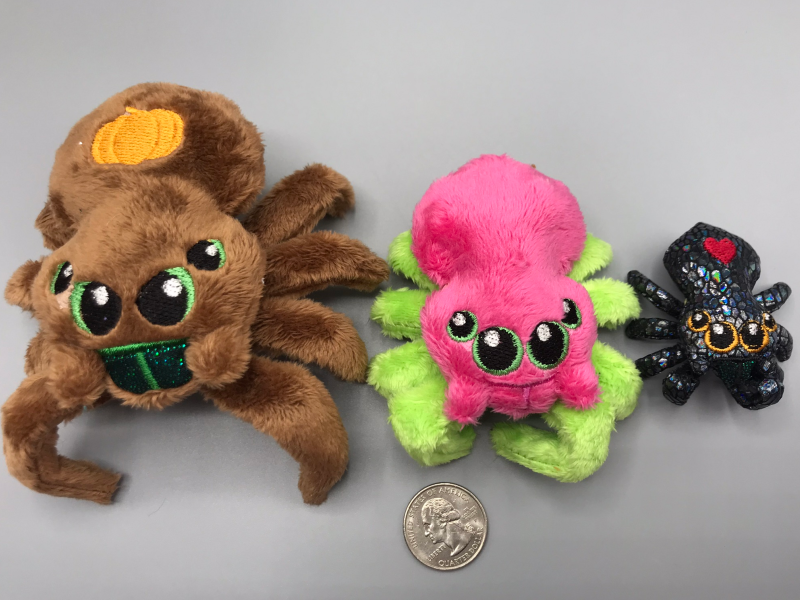
Resizing plushies
Wed, 21 Sep 2022
I've written in the past about resizing embroidery, and why it's easiest when you have the SVG (vector) source. But what if you want to resize plushies, with or without embroidery? I always include the Ink/Stitch files so you can theoretically size anything up, larger or smaller. Can't you just resize things as big or small as you want?
Well...
Sizing down
Sizing down has a couple of issues.
Even in vector form, you can't always just resize the embroidery unchanged. I half-sized the Jumping Spider because why not, and didn't change the eye embroidery because it was a quick test. If you look closely, you can see it's pretty rough.
Sometimes seam allowances collide. The Realistic Octopus has eight legs compressed into a pretty small space, which results in minimal seam allowances. Those shrink along with the rest of the design if you downsize.
Sometimes smaller pieces aren't turn-able. My plush dragons are about as small as they can be at 4" tall.
Smaller means blobbier. The plushie gets smaller but the minky pile doesn't, and details can get lost.
There are fixes for this, sometimes. The embroidery can be modified; too-small satins can become running stitches, or simplified out altogether. Some fabrics require smaller seam allowances (dance/swimsuit fabric can get be with almost nothing, for instance). The "baby" form of my plush dragons came about because I wanted to downsize the dragons and so made a chunkier version of the design. Later, I made smaller version of the adult dragons by using mochi, which incorporates spandex and has more stretch. This also fixes the blobbiness - 1mm mochi pile, stretch velvet, adds less bulk to the contour, and dance/swimsuit fabric adds none.
Other things can't be fixed: the Jumping Spider can only shrink so far because the bases of the legs are limited to 1/4 of the length of the leg intersection. Once you reach the mechanical limit of even spandex fabrics, you're done. Half-size of the larger spider is about it. (Of course, you could break up the leg assembly up into multiple parts and eliminate that chokepoint, until you again run into the limit on leg size itself.) The smallest octopus has seam allowances that already assume you're using mystique spandex or the like. And the Tree Frog's fingers are the size they are because that's the (proportionate) size of a Tree Frog's fingers, and they're barely turnable as it is.
Sizing up
What about going the other way?
Obviously, hoop size is a limit for in-the-hoop, but you can always just print out the scaled-up SVGs of an in-the-hoop design and use them as a conventional sewing pattern.
Resizing the surface embroidery is doable in the other direction, with some limits - wider satins and larger fills distort the fabric more, and eventually satins are just too large to sustain.
Seam allowances are no problem in this direction, other than remembering to scale the seam line and not the cutting line if you're scaling up a conventional pattern. And turning is much less of a problem.
But there's a new problem: the Mylar balloon issue.
At smaller sizes the inherent stretch of the fabric - even just bias stretch on wovens - lets you stuff even flat-sewn plushies some before you get puckering on the edges. This is why smaller plushies like the in-the-hoop plush dragon can be entirely flat-sewn, but still end up with a lot of shape in the finished object - well-rounded limbs and a nearly conical head.
Pile scale is also a problem the other direction. Minky starts to look pretty sparse on larger plushies, and sometimes that makes a big difference. If you have a plushie with a leg that's 10mm in diameter, made in standard minky, the final leg is really about 15mm. Doubling the pattern results in a 25mm leg instead of a 30mm one, and so forth.
Structural support is also an issue. At the normal, small sizes, my little dragons' wings are self-supporting in minky. Even at 4", quilting-cotton wings tend to droop, and even in minky anything larger than about 5" won't keep its wings spread.
There are also fixes for all this, sometimes. Splitting satins, and changing large fills into appliques can fix the embroidery. Minky can be upgraded to faux furs, though that's problematic in the hoop. (At least one person has successfully made an oversized Jumping Spider in faux fur though!) And with larger plushies comes the need for internal structure: usually wires.
But at a certain point, you have a Mylar balloon on your hands, and you need to start putting in gussets and darts or you'll have too much fabric around the edges and not enough across the middle. This requires redrafting the pattern, which is a whole different ballgame - doubly so for in-the-hoop.
To a certain extent, scaling up or down is just a matter of experimentation. If you've followed me for long at all you'll know that I like to push boundaries, and that's how you learn: keep sizing things up or down, and see what happens. Eventually you'll get a feel for the limits of your fabrics and tools.
Comments are not available.
